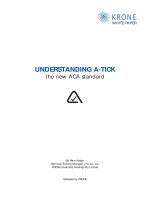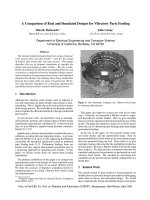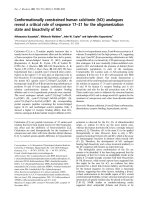BitAsean White paper A PeertoPeer Digital Currency and Payments Ecosystem for the ASEAN Region
Bạn đang xem bản rút gọn của tài liệu. Xem và tải ngay bản đầy đủ của tài liệu tại đây (549.44 KB, 10 trang )
BitAsean
A Peer-to-Peer Digital Currency and Payments Ecosystem for the ASEAN Region
Bytecode Team
Rama VII
Bangkok, Thailand
August 27, 2017
Abstract
BitAsean is a decentralized digital currency for use in commerce on a peer-to-peer
Basis, facilitating both Business-to-Business (B2B) and Business-to-Consumer (B2C) transactions and
settlement. BitAsean was originally launched June 3, 2017, and is the first digital currency developed in
the ASEAN region. BitAsean is not owned by any single entity or party. Rather, it is a digital currency
obtainable through means of exchange by anyone who chooses to accept and/or spend it. It uses the
mechanism of a fully decentralized ERC-20 protocol token (BAS) on the Ethereum blockchain. As such,
it can benefit from the innovation, utility, and security of the battle-tested Ethereum smart contract
platform and virtual machine. Our team has studied the needs of commerce and remittance throughout the
ASEAN region and developed BAS to be useful across a number of diverse use cases which serve to
alleviate some of the inefficiencies of small business, direct-to-consumer merchant sales, and supply
chain.
Additionally, by resisting the currently popular practice of distributing coins through an Initial
Coin Offering (ICO), BitAsean is compliant with US SEC guidance on ICOs. Instead of an ICO our
approach is to get BAS into as many hands as possible, near term, in real world commerce through
distribution methods which will incentivize business and consumer end users, thus building a network
effect and token value through actual usage
1. Introduction
Blockchain technology came to the forefront because it solves problems with regards to trust and
transparency with regards to, but not limited to settlement. Through the use of a blockchain-based
distributed ledger, transactions are transparent, immutable and secure, thus solving a plethora of problems
associated with online payments and centralized systems which traditionally have required some level of
trust that the ledger was both accurate and secure. Furthermore, all parties to a transaction can verify that
it has, in fact, taken place as intended.
This has many uses which will resonate within the ASEAN region and we have tailored our digital
currency to be useful both as a means of exchange and remittance, as well as for potential uses in mobile
apps and mobile gaming or a points system similar to loyalty cards for merchants.
BitAsean (BAS) it should be noted is the first digital currency to emerge from the ASEAN region and we
hope to make it the number one digital currency of choice within ASEAN by having a responsive and
agile path of development working hand-in-hand with end users.
Through the use of our blockchain token, BitAsean (BAS) a new way of doing business will emerge in a
region where blockchain technology is quickly becoming popular. Because BitAsean is made in the
ASEAN region our visibility, “on-the-ground” and face-to-face network and community building will
help carve out BitAsean’s place within of the growing global digital currency space.
Our team is dedicated to the hard work and community building to make that happen across the region
and beyond.
2. Our Approach
BitAsean from the very beginning has been in favor of both the fair distribution of the 30 million
BAS token as well as near-term real world use of the token. This is why originally we launched BAS as a
Cryptonote-based coin on its own blockchain rather than as a token with an ICO crowdsale. Our
distribution of the initial token was through Proof-of-Work mining using the Cryptonite algorithm where
miners were awarded for finding blocks. In theory, anyone with a CPU could mine some BAS and begin
using it. For various reasons having to do with efficient use of resources and future-proof utility, we
decided to transition from the proof-of-work mined coin to an Ethereum-based ERC-20 token atop
Ethereum’s blockchain.
In doing this we re-created the total of 30 million coins which were going to be eventually mined and
divided them as follows:
●
20 million coins allocated for future distribution to merchants (stores, restaurants, etc) that have
accepted BitAsean as a form of payment as well as for future marketing campaigns.
●
5 million coins allocated for the coin swap for old BAS mined using Cryptonite proof-of-work.
●
5 million coins allocated for our development team.
A coin-swap was announced and has been executed for mined coins held by users in their wallets or on an
exchange. This swap was trouble free, seamless and successful.
3. Mobile Wallets
We approach every aspect of the development of the BitAsean ecosystem in a methodical and
logical way. This is why we are working on developing a mobile wallet for Android and iOS users. As
usability of digital currencies is key in our highly mobile society, a well-made mobile wallet app is the top
priority of our team. Once the wallet has been developed and completed our distribution plan for the
20,000,000 BAS token will become paramount. The reasons for this is that it will be easier to get
merchant adoption once customers can actually spend BAS via the mobile wallet.
This wallet will provide the basic send/receive functionality and may later evolve to include more
advanced features. We have also submitted our project to Shapeshift.io and if they were to add BAS we
would add Shapeshift functionality to the wallet. Additionally, as an Ethereum token, it may be a trivial
matter to be added to a multi-coin wallet such as Jaxx which already includes Shapeshift onboard. Our
plan is to release our mobile wallet by the end of 2017 (see Section 5 - Roadmap).
4. Distribution
As mentioned earlier, we plan to distribute the remaining 20 million BAS tokens which are
currently not in circulation in a variety of ways. We’ve chosen this route rather than create an ICO in an
effort to jumpstart the BAS economy by getting the majority of BAS into use in day-to-day transactions.
This means we will get BAS into hands of the businesses which will accept BAS for use in
commerce and by extension, this gets BAS into the hands of their customers through loyalty points or
bonus programs.
The 20 million BAS tokens currently account for 66.7% of the total supply so it is imperative that
these find use in day-to-day transactions. To that end, with consultation with businesses which may use
BAS we’ve come up with a number of novel ideas for how to facilitate this.
●
BAS used as points in lieu of a traditional loyalty card for frequent customers.
●
BAS used to reward customers who pay the listed price for an item rather than haggle in
B2C transactions.
●
BAS used as a frictionless, near instant means of settlement in B2B transactions across
the ASEAN region and beyond.
●
BAS used as a reward in regionally produced mobile apps and games in the various
nations of ASEAN.
Participating businesses will receive highly visible signs and/or stickers which will state “BitAsean
Accepted Here”.
Everyday usage in the aforementioned merchant use cases will lead to higher BitAsean and
liquidity which benefits all who participate in the BAS ecosystem. However, to achieve this the mobile
wallet app will be required so expect the main distribution phase to begin immediately following the
release of the mobile wallet. We are currently working on building a network of retailers and merchants
willing to participate in the initial phase in Thailand and will look to rapidly scale up this phase to include
businesses throughout the ASEAN region.
5. Developmental Roadmap
●
June 2017 - BitAsean P-o-W Blockchain Launched
●
July 2017 - BitAsean ERC-20 Token Created, P-o-W Blockchain Deprecated, Coin Swap
Initiated
●
●
August 2017 - Exchange Launch (EtherDelta, HitBTC), Coin Swap Concluded
September 2017 - Mobile Wallet Development Begins
●
October 2017 - Networking with early adopter (Phase 1) Merchants
●
November 2017 - First “BitAsean Accepted Here” Signs and Stickers to Participating Phase 1
Merchants
●
December 2017 - Mobile Wallet Released
●
Q1 2018 - Marketing and Advertising Campaign
●
Q2 2018 - Phase 2 - Increase number of participating merchants.
●
Q3 2018 - Seek BAS partners interested in integration in mobile apps and games developed in the
ASEAN region
●
Q4 2018 - Phase 3 - Increase number of participating merchants to be double what they were in
Q2.
6. Market Cap Roadmap
By executing our near-term developmental roadmap and building upon it, we hope to increase the BAS
market cap over the next four years as shown below:
7. What is Ethereum and What Are Ethereum Tokens?
According to the Ethereum.org website “Ethereum is a decentralized platform that runs
smart contracts.” This is a simple explanation for what is a complex and revolutionary use of
blockchain technology first pioneered by Bitcoin. It, therefore, is helpful to illustrate how
Ethereum differs from Bitcoin so as to have a better understanding of what Ethereum is.
Bitcoin has been described as digital money or digital gold. Bitcoin originally was created
about eight years ago and is used to transfer money from one person or business to another. It
is commonly used as a store of value and due to its legacy status, Bitcoin has created the most
common way for the public to understand the concept of a decentralized digital currency.
Ethereum differs from Bitcoin because it allows for smart contracts which have been
described as highly programmable digital money. This enables one to automatically send
money from one person to another only when a certain pre-defined set of conditions are met.
This allows for direct, efficient, peer-to-peer transactions which traditionally have involved
multiple third parties such as lawyers and escrow agents. With Ethereum, smart contract code
can automatically transfer ownership of something from one entity to another with the funds
going to the seller once the conditions of a deal are agreed upon without needing a third party to
execute on their behalf.
Many of the centralized systems we use today can be and are being built in a
decentralized manner on Ethereum. Ethereum makes these transactions trustless which allows
for a diverse assortment of decentralized applications. Decentralization eliminates choke points
and single points of failure.
In a nutshell, Ethereum can best be described as infrastructure which allows for the
development and deployment of smart contract based decentralized applications.
Ethereum tokens are one such application utilizing Ethereum’s smart contract code. An
Ethereum token is simply a digital asset being built on top of the Ethereum blockchain
infrastructure. Because of this they benefit from Ethereum’s existing infrastructure which
includes constant development, upgrades and innovation. Instead of developers having to build
their own proprietary blockchain they are free to develop actual use of their application or token.
Ethereum’s developer community came up with a token standard known as ERC-20 which
many tokens including BitAsean (BAS) use.
8. BitAsean Token Specifications
Token standard : ETH based token (ERC20)
Contract address : 0x2a05d22db079bc40c2f77a1d1ff703a56e631cc1
Total coins : 30,000,000 BAS (0.00000001 BAS = 1jk)
Token decimals : 8
Mining : Not mineable
Token symbol : BAS
ICO : No
9. Conclusion
In our increasingly connected region and world, the promise of frictionless, peer-to-peer
payment/settlement serves to help businesses transact more effectively and efficiently with each other,
alleviate pain-points associated with cross-border commerce, incentivize loyal customers, engage and
empower communities. Through the use of blockchain technology and specifically our locally/regionally
aimed Ethereum based ERC-20 token known as BAS, we aim to build an economic ecosystem through
hands-on guidance and engagement with many businesses and markets where digital currency has yet to
make inroads. We offer a solution made in the region for the region. Through network effects, we plan to
build BitAsean (BAS) into the digital currency of choice throughout the ASEAN region by thinking
regionally and tailoring our approach and offering in a favorable way locally. In doing this we feel we can
ultimately realize the incredible potential and promise of this technology for the benefit of all stakeholders
in this endeavor.
References
[1] Satoshi Nakamoto.
Bitcoin: A Peer-to-peer Electronic Cash System.
Oct 2008.
[2] Fred Erhsam. Blockchain Tokens and the dawn of the De-centralized Business Model.
/>1e734f, August 2016
[3] Casey Hynes. How Thailand Could Become Southeast Asia's Next Fintech Hub.
/>tech-hub, June 2017
[4] US SEC. Investor Bulliten: Initial Coin Offerings.
July 2017
[5] Ali Makhdoumi et al. Strategic Dynamic Pricing with Network Externalities.
June 2017.
[6] Fred Erhsam. Tokens, Why How. />.
[7] Ethereum. Ethereum.
.
[8] Gavin Wood. ETHEREUM: A Secure Decentralised Generalised Transaction Ledger.
Feb 2015.
[9] Nick Szabo. Formalizing and Securing Relationships on Public Networks.
Sep 1997.
[10] Linda Xie. A Beginner’s Guide to Ethereum.
Feb 2017
[11] Linda Xie. A Beginner’s Guide to Ethereum Tokens.
May 2017









